8+ Sample Kitchen Inspection Checklist
-
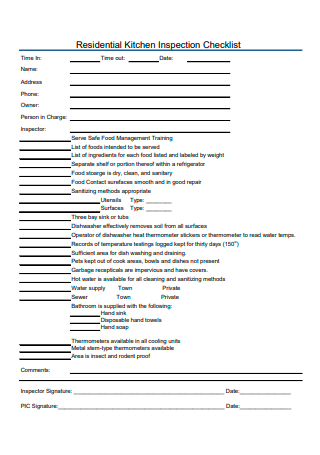
Residential Kitchen Inspection Checklist
download now -
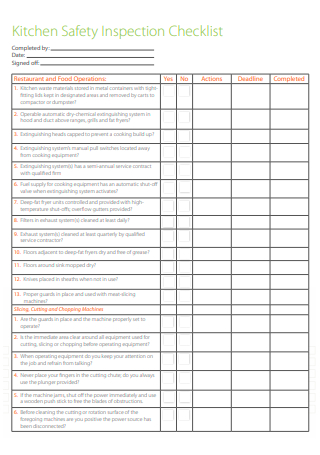
Kitchen Safety Inspection Checklist
download now -
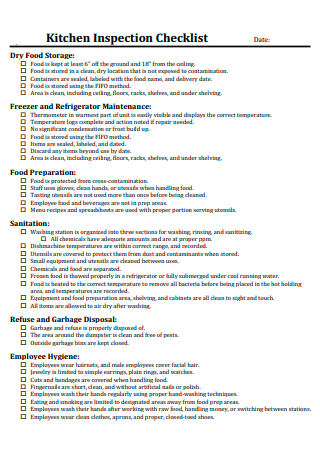
Basic Kitchen Inspection Checklist
download now -
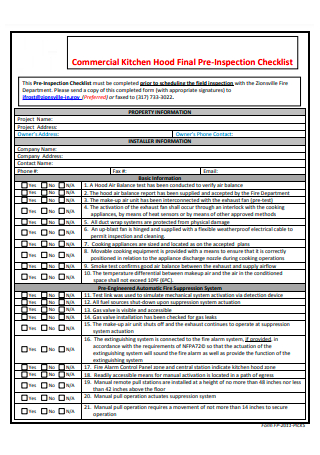
Commercial Kitchen Final Pre-Inspection Checklist
download now -
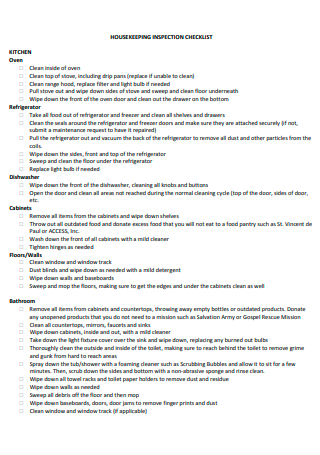
Kitchen Housekeeping Inspection Checklist
download now -
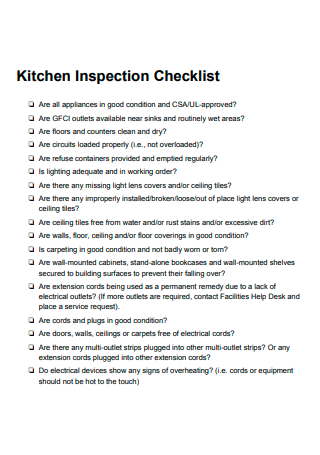
Kitchen Inspection Checklist in PDF
download now -
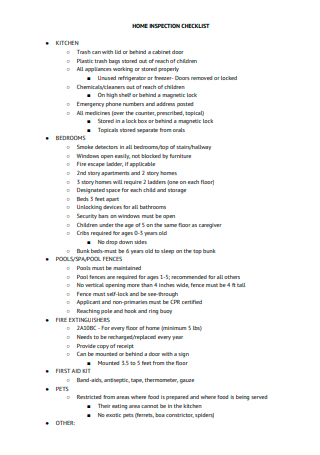
Kitchen Home Inspection Checklist
download now -
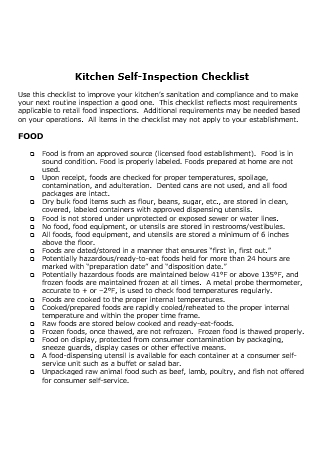
Kitchen Self-Inspection Checklist
download now -
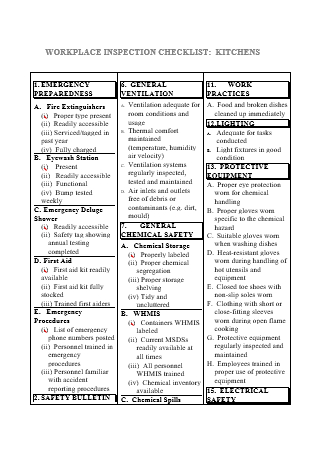
Kitchen Workplace Inspection Checklist in DOC
download now
FREE Kitchen Inspection Checklist s to Download
8+ Sample Kitchen Inspection Checklist
What Is a Kitchen Inspection Checklist?
Make a Checklist for Routine Maintenance
How to Write a Kitchen Inspection Checklist
Prepare for a Home Kitchen Inspection with These Tips
What are the things that the inspectors will be looking for?
What happens if a food safety violation is issued?
FAQs
What are health inspections in restaurants?
When do health inspections of restaurants take place?
How to Pass a Health Inspection at a Restaurant
What Is a Kitchen Inspection Checklist?
Kitchen inspections take place once a year, usually during the autumn term. They arrive unannounced and are arranged by your company’s approved and authorized inspection crew. To keep a residential or restaurant kitchen open, this inspection must be passed. If breaches are discovered, the chapter will be notified of the areas where the kitchen failed to fulfill the required standards. Before another inspection, the company will have 24 hours to correct the problems. Restaurant managers should examine the Kitchen Cleaning Checklist or kitchen equipment inspection checklist placed in kitchens and convey this information to all members of the restaurant and the chef in advance of the inspection.
Make a Checklist for Routine Maintenance
If you are asking yourself how can you create consistent regular Maintenance that you can do within the kitchen, then the short and direct answer would be to create a checklist suitable for your kitchen. Make a daily checklist of activities that must be completed in order for your commercial kitchen to meet health code requirements. Make sure that your team knows who is in charge of certain duties and that they are done on a regular basis. Sanitizing surfaces, cleaning kitchen equipment, emptying trash bins, cleaning floors, ensuring materials and cooked meals are properly stored, and so on could be on the list.
How to Write a Kitchen Inspection Checklist
Now that a kitchen inspection has been defined and elaborated on the importance of a checklist as an aid for routine maintenance checklist, we are now going to proceed to the actual inspection checklist for the kitchen, since there are various checklists available, then you must specify the utmost needs of your kitchen. Think of it as a home kitchen inspection checklist, you would want to ensure the safety of your own kitchen, why not elsewhere as well, right? Even if the sample kitchen inspection checklist has been provided for you, you must also make sure that the checklist you will be making fits into the needs of your own kitchen. Nevertheless, the following details are common and generally found for all kitchens.
Step 1: Proper Food Storage
Perishables and prepared foods should be refrigerated or frozen within 2 hours after receiving food deliveries. Make sure the refrigerator isn’t overflowing. To keep food safe, cold air must flow. In the refrigerator or freezer, every food must be adequately covered and there must be no exposed containers. Aluminum cans should not be used to store acidic foods. Spices should be covered while not in use.
The pantry and food storage spaces must be cleaned on a regular basis. For storage, all food products must be six inches above the ground. Meat should not be kept out for long periods of time even to defrost. Under running water, in the refrigerator, or through cooking are the only methods to effectively thaw meat. Before you start cooking, make sure the area is clean.
Step 2: Staff Personal Hygiene
Before and after preparing meals, employees wash their hands in a dedicated handwashing sink using correct handwashing procedures, as well as utensils and surfaces with hot, soapy water. After sneezing, coughing, blowing their nose, or using the toilet, employees wash their hands. Employees who are sick are sent home, and cuts and wounds are treated.
Plain band rings and watches are the only pieces of jewelry that can be worn on the hands and arms. At the outset of each new activity, such as dealing with raw food, handling money, or transferring between stations, employees wash their hands and put on a new pair of single-use gloves. Hair, especially facial hair, is covered by kitchen staff. Closed-toe shoes should also be worn by employees. Using your hands or drinking vessels to get ice is not a good idea. Make use of the ice scoop that is included with the ice maker. Keep the ice scoop in a protective sleeve or in the ice machine with the handle pointing out.
Step 3: Make use of the right utensils and appliances.
Only utilize appliances that have been authorized for use in a restaurant kitchen level. Microwave-safe containers and plates should be used properly. Cook for the appropriate amount of time and at the appropriate temperature.
Read the guidelines before you start cooking to ensure appropriate food preparation. Cooking on the stovetop should be done over medium heat. Consider how long goods should be microwaved. Make sure you keep an eye on your cooking and don’t walk away. While cooking, stay in the kitchen area. Make sure you don’t get sidetracked and leave your meal unattended. After you’ve finished cooking, clean up. Make sure the stovetop and oven are clean at all times. Smoke and fire might develop from the heating residue left over from prior cooking.
Step 4: Spills should be wiped up as soon as possible.
Items should be stored or thrown away so that they do not obstruct those who are using the facilities. Throw away any perishable food that you think won’t be consumed at any time soon. To avoid food contamination, clean the countertops. Refrigerators and microwaves should be cleaned on a regular basis. Sanitizers should be properly labeled and stored in spray bottles. Remove any rubbish and debris from the Kitchen.
Step 5: Pest Prevention
Walls and doors with visible gaps and cracks are patched or covered. Food that has been shelved is kept in airtight containers. Overnight, the floors are free of crumbs and spills. Garbage cans are emptied on a regular basis and should be washed regularly. Outside garbage cans should have tight-fitting lids to keep flies, roaches, and other pests out. Dumpsters, garbage, and vegetation that provides cover for rodents are kept away from all doors. Inside are non-poisonous traps that aren’t damaging to the fresh vegetables or components.
Prepare for a Home Kitchen Inspection with These Tips
These pointers will assist you in preparing for your home kitchen as well as restaurant management inspections and ensuring a smooth process. An environmental health inspection is mandatory for most establishments in order for people to be safe and away from the harm that may be dangerous not only to the staff but also to the customers that are visiting where the restaurant is. It functions in a similar fashion for a Food Safety Inspection Checklist where the priority falls to the safety of the people.
What are the things that the inspectors will be looking for?
The most straightforward method to ensure a successful kitchen inspection is to stay up to date on the most essential health and hygiene standards and ensure that your company meets these responsibilities on a regular basis. The following is a list of requirements that inspectors will look for when they come to your place of business.
What happens if a food safety violation is issued?
The most essential thing to remember if you receive a violation is to remain calm. Your top goal should be to discover and execute a solution as soon as possible. These violations are merely for you to keep in mind of and to at least know what is best to avoid and improve of immediately.
FAQs
What are health inspections in restaurants?
An inspection of your restaurant, personnel, and food products for potentially harmful or dangerous ingredients is called a Restaurant health inspection. This might happen during storage, manufacturing, processing, or even packing. The way you store, defrost, and prepare food will be scrutinized by a health inspector. He or she will also inspect your kitchen, storage spaces, and freezers for cleanliness.
When do health inspections of restaurants take place?
They usually happen every 6 months at random, but if a client ever complains, a food inspector is required to come to visit you. Inspections of the kitchen may be done at any time, and the frequency of the inspections can be increased depending on the possible dangers to clients that your business poses. If you are a member of a recognized assurance program, you may be able to decrease the number of visits.
How to Pass a Health Inspection at a Restaurant
Remember that a health inspector’s job is to enforce food safety regulations and keep customers safe. Keep current with the latest health standards, food safety procedures, and safe handling and preparation techniques. You’ll ace your next restaurant inspection if you implement processes that ensure that all of your employees prioritize Food Safety checklist and workplace hygiene. There may not be an incentive for passing an inspection, but getting a good grade will keep existing customers coming back and attract new ones.
Small company owners may be intimidated by the idea of a kitchen inspection, but in fact, these procedures are nothing more than a normal formality for a professionally operated or authorized company that satisfies its food safety responsibilities on a regular basis. Don’t be intimidated because the main purpose of a kitchen inspection is merely to ensure the quality that your restaurant’s kitchen releases. This is why it is important to have a kitchen Health and Safety Checklist that fits into your own kitchen needs in order to assess it in a closer and personal way. Utilize the available kitchen safety checklist templates so you won’t have to start from scratch.
